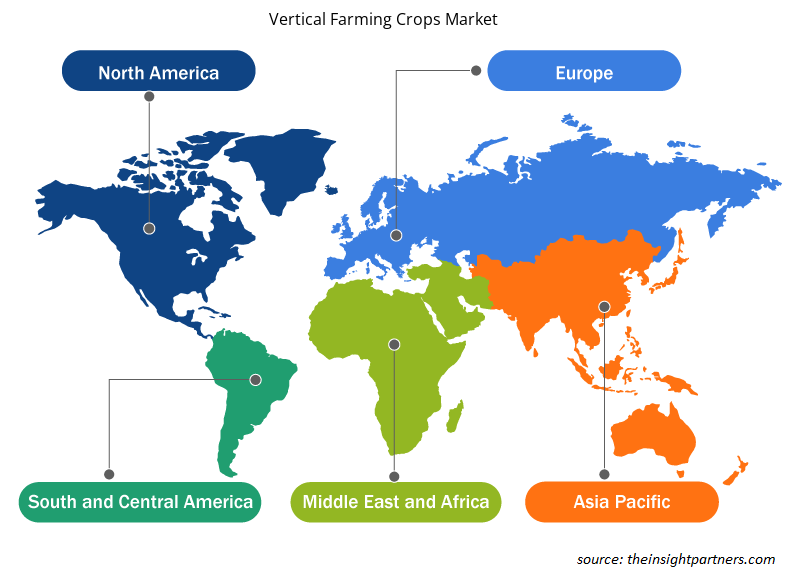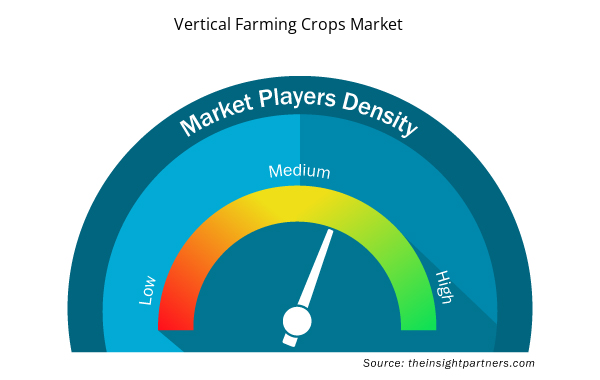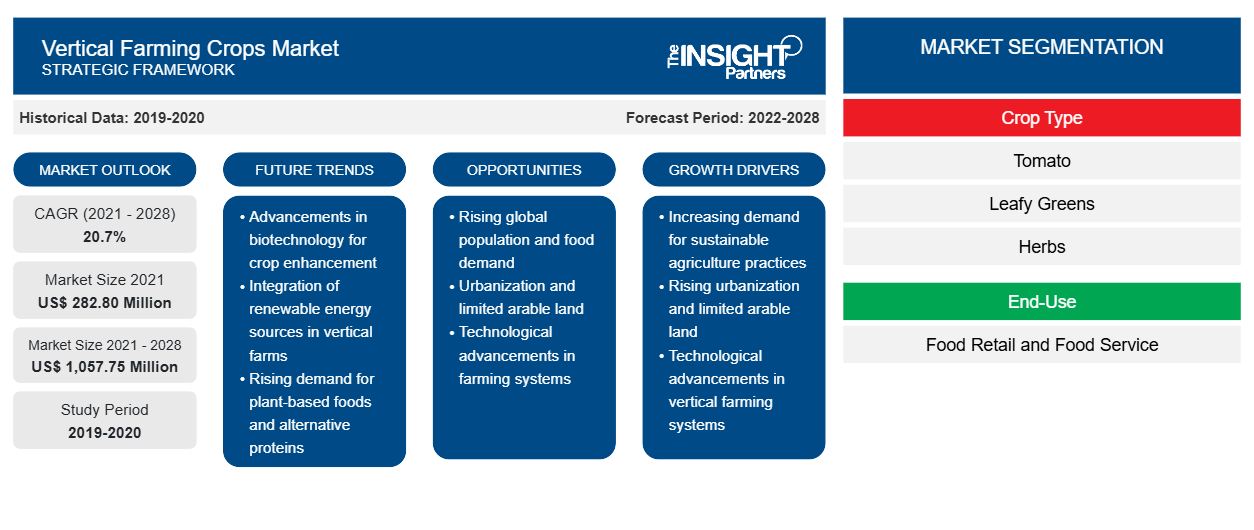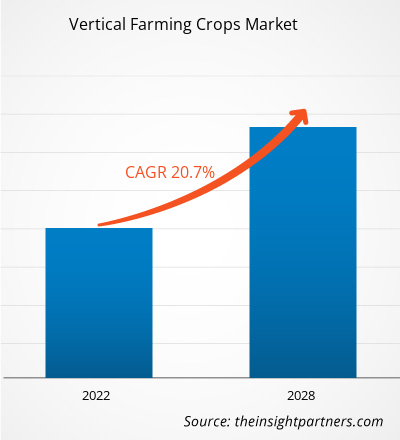[調査レポート] 垂直農法による作物市場は2021年に2億8,280万米ドルと評価され、2028年までに10億5,775万米ドルに達すると予測されています。2021年から2028年にかけてCAGR 20.7%で成長すると予想されています。
垂直農法では、栄養培地を詰めたトレイに垂直に積み重ねた層で作物を栽培します。作物の栽培に土や土地を使用しない近代的な農業技術です。さらに、従来の農業で通常使用される殺虫剤、化学肥料、その他の合成資材も使用しません。垂直農法は、耕作地が不足している都市部でますます導入されています。
アジア太平洋地域は、予測期間中に世界の垂直農法作物市場において最速のCAGRで成長すると予想されています。市場を牽引する主な要因は、技術革新とオーガニック食品の需要増加です。アジア太平洋地域の人口は劇的に増加しています。人口増加は食品需要を刺激し、垂直農法作物市場のプレーヤーにさらなる機会を提供します。さらに、都市化の進行と近代的な農業慣行の採用の増加も市場を推進しています。
さらに、垂直農法作物市場の主要プレーヤーは、積極的にイノベーションに注力しています。主要企業は研究開発に多額の投資を行っており、生産量を増やすために新興技術を採用しています。たとえば、シドニーを拠点とする新興企業であるPodPlants は、軽量で持ち運び可能な垂直庭園を開発し、その独自の技術でオーストラリアイノベーションチャレンジを受賞しました。このような技術の進歩は、今後の期間に地域の市場成長を促進すると予測されています。
要件に合わせてレポートをカスタマイズする
このレポートの一部、国レベルの分析、Excelデータパックなど、あらゆるレポートを無料でカスタマイズできます。また、スタートアップや大学向けのお得なオファーや割引もご利用いただけます。
- このレポートの主要な市場動向を入手してください。この無料サンプルには、市場動向から見積もりや予測に至るまでのデータ分析が含まれます。
COVID-19が垂直農法作物市場に与える影響
COVID-19パンデミックは、世界の食品・飲料業界を含むさまざまな業界に前例のない課題をもたらしました。ロックダウン、渡航禁止、製造工場の閉鎖により、サプライチェーンは深刻な混乱に陥り、売上の減少につながりました。さらに、製造部門は原材料と労働力の不足により製品供給不足に直面しました。しかし、垂直農法の作物市場は、地元産の新鮮なオーガニック製品への需要によりプラス成長を遂げました。さらに、個人の健康意識の高まりにより、今後数年間で垂直農法の作物に収益性の高い成長機会が生まれると予測されています。
市場分析
AI制御垂直農場の人気の高まり
AI制御の垂直農場は、作物の成長パターン、どの作物がより収穫量が多いか、作物に必要な気候条件、およびその他の要因に関連するデータを提供することで、栽培者が作物の収穫量を最適化できるようにします。栽培者はこのデータを分析し、収穫量を改善するために必要な措置を講じることができます。人工知能(AI)は、主要な作物の成長の制御からどの作物がより収穫量が多いかを予測することまで、気候変動や資源の不足などの最大の課題に立ち向かう業界に役立ちます。人工知能も増加しており、1,600を超える新興企業と総投資額が数百億ドルに達しています。AI制御のロボットは植物の成長を監視し、環境要因を継続的に調整して、効率と経済的な成果を高めます。したがって、人工知能(AI)とモノのインターネット(IoT)は、垂直農法の作物市場の主要なトレンドになると予想されています。
作物の種類に関する洞察
作物の種類に基づいて、垂直農法の作物市場は、トマト、葉物野菜、ハーブ、その他に分類されています。葉物野菜セグメントは2019年に最大の市場シェアを占め、ハーブセグメントは予測期間中に市場で最高のCAGRを記録すると予想されています。葉物野菜には、レタス、ケール、コラードグリーン、ほうれん草、水菜、ビートグリーン、マイクログリーンが含まれます。葉物野菜は、比較的狭いスペースで急速に栽培できるため、屋内農業に適しています。食品小売店や食品サービス部門からの新鮮な葉物野菜の需要の高まりは、このセグメントの成長を促進する主な要因の1つです。さらに、「農場から食卓まで」のトレンドの高まりも、垂直農法の葉物野菜の需要を促進しています。葉物野菜作物の屋内栽培に関する研究費の急増は、市場成長の有利な機会を提供しています。
エンドユースの洞察
最終用途産業に基づいて、垂直農法作物市場は、食品サービスと食品小売に分類されています。食品小売セグメントは、2020年に大きな市場シェアを占めました。食品サービスセグメントは、地元の食品販売業者、レストラン、カフェ、クイックサービスレストランからの新鮮で高品質の農産物に対する需要の増加により、予測期間中に高いCAGRを記録すると予想されます。さらに、レストランやカフェで新鮮なサラダを消費する顧客の傾向が高まっていることから、食品サービス部門からの垂直農法作物の需要が高まっています。一部の市場プレーヤーは、食品サービスプロバイダーと提携してビジネスを拡大しています。たとえば、2019年1月、食品サービスサプライヤーのVan GelderとPlantLabは、PlantLabの完全に管理された垂直農法ユニットでさまざまな新鮮な野菜を生産するためのパートナーシップを締結しました。このようなパートナーシップは、今後数年間で市場をさらに押し上げると予想されます。
農業技術の洞察
農業技術に基づいて、垂直農法の作物市場は、水耕栽培、空中栽培、アクアポニックスに分類されています。水耕栽培セグメントは2020年に最大の市場シェアを占め、空中栽培セグメントは予測期間中に市場で最高のCAGRを記録すると予想されています。水耕栽培では、植物の根は栄養溶液の入ったトレイに沈められます。過去数年間、垂直水耕システムを使用した都市農業が大きな注目を集めています。これらの水耕農場は、最新の技術を使用して植物の成長を最適化し、水の使用量、土地スペース、輸送コスト、農薬の使用を最小限に抑えながら新鮮な農産物を提供することができます。水耕栽培では通常、高品質の作物が生産され、人工知能(AI)やモノのインターネット(IoT)技術などの新興技術を採用することで、栽培者はより良い作物の収穫量を得ることができます。
世界の垂直農法市場における主要企業としては、AeroFarms、Agricool、BOWERY FARMING INC.、CropOne、Infarm、Plantlab、Plenty Unlimited Inc.、Gotham Greens、MIRAI Co. Ltd.、BrightFarms などが挙げられます。これらの企業は、作物の収穫量を増やし、手頃な価格で高品質の作物を生産するために、新興技術に多額の投資を行っています。
垂直農法作物市場の地域別洞察
予測期間を通じて垂直農法作物市場に影響を与える地域的な傾向と要因は、Insight Partners のアナリストによって徹底的に説明されています。このセクションでは、北米、ヨーロッパ、アジア太平洋、中東、アフリカ、南米、中米にわたる垂直農法作物市場のセグメントと地理についても説明します。

- 垂直農法作物市場の地域別データを入手
垂直農法作物市場レポートの範囲
| レポート属性 | 詳細 |
|---|---|
| 2021年の市場規模 | 2億8,280万米ドル |
| 2028年までの市場規模 | 10億5,775万米ドル |
| 世界のCAGR(2021年~2028年) | 20.7% |
| 履歴データ | 2019-2020 |
| 予測期間 | 2022-2028 |
| 対象セグメント | 作物の種類別
|
| 対象地域と国 | 北米
|
| 市場リーダーと主要企業プロフィール |
|
垂直農法作物市場のプレーヤー密度:ビジネスダイナミクスへの影響を理解する
垂直農法作物市場は、消費者の嗜好の変化、技術の進歩、製品の利点に対する認識の高まりなどの要因により、エンドユーザーの需要が高まり、急速に成長しています。需要が高まるにつれて、企業は提供を拡大し、消費者のニーズを満たすために革新し、新たなトレンドを活用し、市場の成長をさらに促進しています。
市場プレーヤー密度とは、特定の市場または業界内で活動している企業または会社の分布を指します。これは、特定の市場スペースに、その規模または総市場価値と比較して、どれだけの競合相手 (市場プレーヤー) が存在するかを示します。
垂直農法作物市場で事業を展開している主要企業は次のとおりです。
- エアロファーム
- アグリクール
- バワリーファーミング株式会社
- クロップワン
- インファーム
免責事項:上記の企業は、特定の順序でランク付けされていません。

- 垂直農法作物市場のトップキープレーヤーの概要を入手
レポートの注目点
- 垂直農法作物市場における進歩的な業界動向は、プレーヤーが効果的な長期戦略を策定するのに役立ちます。
- 先進国市場と発展途上国市場で採用されているビジネス成長戦略
- 2019年から2028年までの垂直農法作物市場の定量分析
- 垂直農法作物の世界需要の推定
- 業界で事業を展開するバイヤーとサプライヤーの有効性を示すPEST分析
- 競争市場の状況を理解するための最近の動向
- 垂直農法作物市場の成長を牽引・抑制する要因と市場動向と展望
- 商業的利益の基盤となる市場戦略を強調し、市場の成長につながる意思決定プロセスを支援する
- 垂直農法作物の市場規模はさまざまなノードで
- 市場の詳細な概要とセグメンテーション、および垂直農法作物産業の動向
- 有望な成長機会があるさまざまな地域における垂直農法作物市場の規模。
作物の種類に基づいて、垂直農法作物市場はトマト、葉物野菜、ハーブ、その他に分類されます。最終用途産業に基づいて、市場は食品小売と食品サービスに分類されます。農業技術に基づいて、市場は水耕栽培、空中栽培、アクアポニックスに分類されます。
- 過去2年間の分析、基準年、CAGRによる予測(7年間)
- PEST分析とSWOT分析
- 市場規模価値/数量 - 世界、地域、国
- 業界と競争環境
- Excel データセット



Report Coverage
Revenue forecast, Company Analysis, Industry landscape, Growth factors, and Trends

Segment Covered
This text is related
to segments covered.

Regional Scope
North America, Europe, Asia Pacific, Middle East & Africa, South & Central America

Country Scope
This text is related
to country scope.
よくある質問
Based on end-user, the food service segment is projected to grow at the fastest CAGR from 2021 to 2028 owing to the rapidly expanding global food service sector coupled with rising demand for convenience, ready-to-consume, and healthy food products.
Based on crop type, the herbs segment is projected to grow at the fastest CAGR over the forecast period owing to the growing demand for high-quality and fresh herbs such as mint, coriander, parsley, basil, rosemary, among others from food retail as well as food service sector.
In 2020, Europe held the largest share in the global vertical farming crops market. The rising adoption of technologically advanced farming techniques coupled with the increasing demand for pesticide-free, hygienically produced agricultural products are they key factors driving the market growth.
The major players operating in the global vertical farming crops market are AeroFarms, Agricool, Bowery Farming Inc., CropOne, Infarm, Plantlab, Plenty Unlimited Inc., Gotham Greens, MIRAI Co., Ltd., and BrightFarms, among others.
Based on farming technique, the hydroponics segment held the largest market share in 2020. Hydroponics involves submerging the plant roots in trays containing nutrient solutions. In hydroponics, 90% less water is utilized compared to traditional agriculture methods. The rising popularity of hydroponics over conventional agricultural practices owing to its benefits is primarily driving the segment’s growth.
Vertical farming crops are crops grown in vertically stacked containers or trays containing nutrient media. Crops such as tomatoes, leafy greens, herbs, berries, bell peppers, cucumber, among others are majorly grown using vertical farming techniques. Hydroponics, aeroponics, and aquaponics are some of the prominent vertical farming methods. Food retail and food service sectors are the key end-users of vertical farming crops.
Trends and growth analysis reports related to Consumer Goods : READ MORE..
The List of Companies - Vertical Farming Crops Market
- AeroFarms
- Agricool
- Bowery Farming Inc.
- CropOne
- Infarm
- Plantlab
- Plenty Unlimited Inc.
- Gotham Greens
- MIRAI Co., Ltd.
- BrightFarms
The Insight Partners performs research in 4 major stages: Data Collection & Secondary Research, Primary Research, Data Analysis and Data Triangulation & Final Review.
- Data Collection and Secondary Research:
As a market research and consulting firm operating from a decade, we have published and advised several client across the globe. First step for any study will start with an assessment of currently available data and insights from existing reports. Further, historical and current market information is collected from Investor Presentations, Annual Reports, SEC Filings, etc., and other information related to company’s performance and market positioning are gathered from Paid Databases (Factiva, Hoovers, and Reuters) and various other publications available in public domain.
Several associations trade associates, technical forums, institutes, societies and organization are accessed to gain technical as well as market related insights through their publications such as research papers, blogs and press releases related to the studies are referred to get cues about the market. Further, white papers, journals, magazines, and other news articles published in last 3 years are scrutinized and analyzed to understand the current market trends.
- Primary Research:
The primarily interview analysis comprise of data obtained from industry participants interview and answers to survey questions gathered by in-house primary team.
For primary research, interviews are conducted with industry experts/CEOs/Marketing Managers/VPs/Subject Matter Experts from both demand and supply side to get a 360-degree view of the market. The primary team conducts several interviews based on the complexity of the markets to understand the various market trends and dynamics which makes research more credible and precise.
A typical research interview fulfils the following functions:
- Provides first-hand information on the market size, market trends, growth trends, competitive landscape, and outlook
- Validates and strengthens in-house secondary research findings
- Develops the analysis team’s expertise and market understanding
Primary research involves email interactions and telephone interviews for each market, category, segment, and sub-segment across geographies. The participants who typically take part in such a process include, but are not limited to:
- Industry participants: VPs, business development managers, market intelligence managers and national sales managers
- Outside experts: Valuation experts, research analysts and key opinion leaders specializing in the electronics and semiconductor industry.
Below is the breakup of our primary respondents by company, designation, and region:

Once we receive the confirmation from primary research sources or primary respondents, we finalize the base year market estimation and forecast the data as per the macroeconomic and microeconomic factors assessed during data collection.
- Data Analysis:
Once data is validated through both secondary as well as primary respondents, we finalize the market estimations by hypothesis formulation and factor analysis at regional and country level.
- Macro-Economic Factor Analysis:
We analyse macroeconomic indicators such the gross domestic product (GDP), increase in the demand for goods and services across industries, technological advancement, regional economic growth, governmental policies, the influence of COVID-19, PEST analysis, and other aspects. This analysis aids in setting benchmarks for various nations/regions and approximating market splits. Additionally, the general trend of the aforementioned components aid in determining the market's development possibilities.
- Country Level Data:
Various factors that are especially aligned to the country are taken into account to determine the market size for a certain area and country, including the presence of vendors, such as headquarters and offices, the country's GDP, demand patterns, and industry growth. To comprehend the market dynamics for the nation, a number of growth variables, inhibitors, application areas, and current market trends are researched. The aforementioned elements aid in determining the country's overall market's growth potential.
- Company Profile:
The “Table of Contents” is formulated by listing and analyzing more than 25 - 30 companies operating in the market ecosystem across geographies. However, we profile only 10 companies as a standard practice in our syndicate reports. These 10 companies comprise leading, emerging, and regional players. Nonetheless, our analysis is not restricted to the 10 listed companies, we also analyze other companies present in the market to develop a holistic view and understand the prevailing trends. The “Company Profiles” section in the report covers key facts, business description, products & services, financial information, SWOT analysis, and key developments. The financial information presented is extracted from the annual reports and official documents of the publicly listed companies. Upon collecting the information for the sections of respective companies, we verify them via various primary sources and then compile the data in respective company profiles. The company level information helps us in deriving the base number as well as in forecasting the market size.
- Developing Base Number:
Aggregation of sales statistics (2020-2022) and macro-economic factor, and other secondary and primary research insights are utilized to arrive at base number and related market shares for 2022. The data gaps are identified in this step and relevant market data is analyzed, collected from paid primary interviews or databases. On finalizing the base year market size, forecasts are developed on the basis of macro-economic, industry and market growth factors and company level analysis.
- Data Triangulation and Final Review:
The market findings and base year market size calculations are validated from supply as well as demand side. Demand side validations are based on macro-economic factor analysis and benchmarks for respective regions and countries. In case of supply side validations, revenues of major companies are estimated (in case not available) based on industry benchmark, approximate number of employees, product portfolio, and primary interviews revenues are gathered. Further revenue from target product/service segment is assessed to avoid overshooting of market statistics. In case of heavy deviations between supply and demand side values, all thes steps are repeated to achieve synchronization.
We follow an iterative model, wherein we share our research findings with Subject Matter Experts (SME’s) and Key Opinion Leaders (KOLs) until consensus view of the market is not formulated – this model negates any drastic deviation in the opinions of experts. Only validated and universally acceptable research findings are quoted in our reports.
We have important check points that we use to validate our research findings – which we call – data triangulation, where we validate the information, we generate from secondary sources with primary interviews and then we re-validate with our internal data bases and Subject matter experts. This comprehensive model enables us to deliver high quality, reliable data in shortest possible time.


 このレポートの無料サンプルを入手する
このレポートの無料サンプルを入手する